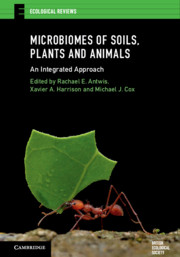Book contents
- Microbiomes of Soils, Plants and Animals
- Ecological Reviews
- Microbiomes of Soils, Plants and Animals
- Copyright page
- Contents
- Contributors
- Preface
- Abbreviations
- Chapter One Microbiomes of soils, plants and animals: an introduction
- Chapter Two Analytical approaches for microbiome research
- Chapter Three Microbiomes of soils
- Chapter Four Factors that shape the host microbiome
- Chapter Five Microbial symbioses and host nutrition
- Chapter Six The microbiome and host behaviour
- Chapter Seven Host microbiomes and disease
- Chapter Eight Adapting to environmental change
- Chapter Nine Microbial biotechnology
- Chapter Ten Synthesis and future directions
- Index
- Plate Section (PDF Only)
- References
Chapter Seven - Host microbiomes and disease
Published online by Cambridge University Press: 07 March 2020
- Microbiomes of Soils, Plants and Animals
- Ecological Reviews
- Microbiomes of Soils, Plants and Animals
- Copyright page
- Contents
- Contributors
- Preface
- Abbreviations
- Chapter One Microbiomes of soils, plants and animals: an introduction
- Chapter Two Analytical approaches for microbiome research
- Chapter Three Microbiomes of soils
- Chapter Four Factors that shape the host microbiome
- Chapter Five Microbial symbioses and host nutrition
- Chapter Six The microbiome and host behaviour
- Chapter Seven Host microbiomes and disease
- Chapter Eight Adapting to environmental change
- Chapter Nine Microbial biotechnology
- Chapter Ten Synthesis and future directions
- Index
- Plate Section (PDF Only)
- References
Summary
Koch’s postulates originally proposed a one microorganism–one disease approach to disease; however, it is now clear that many diseases of plants and animals are associated with changes in the taxonomic composition and function of the microbiome, and that health and disease are mediated by a dynamic interplay between host factors, environmental factors, the host microbiota and pathogenic microorganisms. Commensal microbes can become pathogenic under certain conditions, and disease can arise from complex polymicrobial infections. Although causation and correlation can be difficult to untangle, it is clear that the host microbiome plays a key role in resisting colonisation by pathogens across all host taxa, from plants to animals to humans. This offers exciting possibilities for manipulating microbiomes in order to reduce pathogenic infection in a range of contexts, including agriculture, wildlife and human health, through the use of probiotics, prebiotics and microbiome transplants, among other approaches.
Keywords
- Type
- Chapter
- Information
- Microbiomes of Soils, Plants and AnimalsAn Integrated Approach, pp. 122 - 153Publisher: Cambridge University PressPrint publication year: 2020
References
- 1
- Cited by



